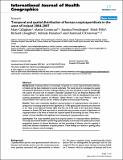| dc.contributor.author | Callaghan, Mary | |
| dc.contributor.author | Cormican, Martin | |
| dc.contributor.author | Prendergast, Martina | |
| dc.contributor.author | Hanahoe, Belinda | |
| dc.contributor.author | O'Donovan, Diarmuid | |
| dc.date.accessioned | 2011-10-25T16:28:54Z | |
| dc.date.available | 2011-10-25T16:28:54Z | |
| dc.date.issued | 2009 | |
| dc.identifier.citation | Callaghan M, Cormican M, Prendergast M, Pelly H, Cloughley R, Hanahoe B, O¿Donovan D. Temporal and spatial distribution of human cryptosporidiosis in the west of Ireland 2004-2007. International Journal of Health Geographics 2009;8:64. | en_US |
| dc.identifier.uri | http://hdl.handle.net/10379/2241 | |
| dc.description.abstract | Background
Cryptosporidiosis is increasingly recognised as a cause of gastrointestinal infection in Ireland and has been implicated in several outbreaks. This study aimed to investigate the spatial and temporal distribution of human cryptosporidiosis in the west of Ireland in order to identify high risk seasons and areas and to compare Classically Calculated (CC) and Empirical Bayesian (EB) incidence rates. Two spatial scales of analysis were used with a view to identifying the best one in assessing geographical patterns of infection. Global Moran's I and Local Moran's I tests of autocorrelation were used to test for evidence of global and local spatial clustering.
Results
There were statistically significant seasonal patterns of cryptosporidiosis with peaks in spring and an increasing temporal trend. Significant (p < 0.05) global spatial clustering was observed in CC rates at the Electoral Division (ED) level but not in EB rates at the same level. Despite variations in disease, ED level was found to provide the most accurate account of distribution of cryptosporidiosis in the West of Ireland but required spatial EB smoothing of cases. There were a number of areas identified with significant local clustering of cryptosporidiosis rates.
Conclusion
This study identified spatial and temporal patterns in cryptosporidiosis distribution. The study also showed benefit in performing spatial analyses at more than one spatial scale to assess geographical patterns in disease distribution and that smoothing of disease rates for mapping in small areas enhances visualisation of spatial patterns. These findings are relevant in guiding policy decisions on disease control strategies. | en_US |
| dc.format | application/pdf | en_US |
| dc.language.iso | en | en_US |
| dc.rights | Attribution-NonCommercial-NoDerivs 3.0 Ireland | |
| dc.rights.uri | https://creativecommons.org/licenses/by-nc-nd/3.0/ie/ | |
| dc.subject | Cryptosporidiosis | en_US |
| dc.subject | Health Promotion | en_US |
| dc.title | Temporal and spatial distribution of human cryptosporidiosis in the west of Ireland 2004-2007 | en_US |
| dc.type | Article | en_US |
| dc.description.peer-reviewed | peer-reviewed | en_US |
| dc.contributor.funder | Environmental Protection Agency | en_US |
| nui.item.downloads | 387 | |


